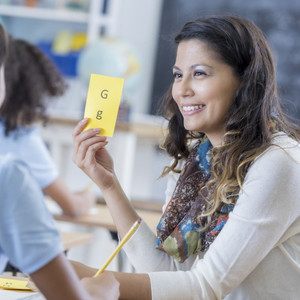Supporting Students with Dyslexia: Innovative Strategies for Classrooms
In today’s diverse classrooms, supporting students with dyslexia requires a multifaceted approach that goes beyond simply understanding the condition. Our understanding of dyslexia and how to support students with this learning difference has evolved significantly. Dyslexia is a neurological condition affecting reading fluency and accuracy that presents unique challenges in phonological awareness, reading comprehension, and written expression. As we embrace a more inclusive educational paradigm for supporting students with dyslexia, adaptive teaching methods can ensure students thrive.
Let’s explore some cutting-edge accommodations and strategies that reflect current best practices. First, consider ways to leverage technology for material accommodations.
Technology for Supporting Students with Dyslexia
- Adaptive reading software utilizes AI-powered apps that adjust text presentation in real-time based on the student’s reading patterns.
- Augmented reality (AR) learning tools implement applications that overlay visual aids onto physical texts, enhancing comprehension.
- Smart pens introduce digital pens that record audio while students take notes, allowing them to revisit lessons easily.
Innovative Teaching and Learning Approaches
- Neurodiversity-affirming instruction embraces teaching methods that celebrate different learning styles, fostering a positive self-image when supporting students with dyslexia.
- Gamification of phonics uses educational games that make phonological awareness training engaging and interactive.
- Peer-assisted learning strategies (PALS) implement structured peer tutoring programs that benefit both students with dyslexia and their peers.
Supporting Students with Dyslexia through Accommodations
Reimagine ways that you might rework classwork across subject areas to support students with dyslexia.
Picture a classroom where demonstration of learning isn’t confined to traditional methods, but instead overflows with possibilities. Imagine Sarah, a bright student who struggles with written exams but shines when given the chance to express herself creatively. In this reimagined classroom, Sarah’s history class teacher doesn’t limit her to a standard essay test. Instead, Sarah produces a captivating video presentation, weaving together historical facts with compelling visuals and her own narration.
Now, envision a science class where the daunting topic of photosynthesis isn’t presented as one overwhelming concept. Instead, it’s broken down into bite-sized, micro-learning modules. Students like Marco, who often feel overwhelmed by complex topics, can now tackle one small piece at a time. One day, he’s exploring the role of chlorophyll through an interactive animation. The next, he’s investigating the light-dependent reactions through a virtual lab simulation. This approach prevents cognitive overload and allows Marco to build his understanding step by step, celebrating small learning victories along the way.
Finally, consider the power of personalized learning plans. Meet Emily, a student who excels in mathematics but struggles with language arts. In this reimagined classroom, Emily’s learning management system adapts to her unique needs. While she breezes through advanced algebra modules, the system recognizes her need for extra support in reading comprehension. It automatically adjusts, providing her with additional resources, such as interactive vocabulary games and guided reading exercises. Meanwhile, her classmate Jamal, who has the opposite strengths, receives a curriculum that challenges him in math while allowing him to soar ahead in literature studies.
In this reimagined learning environment, accommodations aren’t just afterthoughts or exceptions – they’re woven into education. Every student becomes an active participant in their learning journey, with freedom to showcase their knowledge in ways that play to their strengths and support to improve in areas of challenge. This is a classroom where diversity in learning styles isn’t just acknowledged, but celebrated, fostering a rich, inclusive educational experience for all.
Emotional and Social Supports for Students with Dyslexia
- Mindfulness practices incorporate short exercises to help students manage stress and improve focus.
- A strengths-based approach identifies and nurtures each student’s unique strengths, building confidence alongside academic skills.
- Dyslexia mentorship programs connect students with successful dyslexic individuals in various fields to provide inspiration and guidance.
By integrating these innovative strategies, educators can create a more inclusive and effective learning environment for supporting students with dyslexia. Remember, the goal is not just accommodation, emotional and social supports, or feel goods, but empowerment – enabling these students to leverage their unique perspectives and abilities.
Want to dive deeper into supporting students with dyslexia? Enhance your skills with our comprehensive “Writing and Dyslexia” online professional development course. Consequently, equip yourself with the latest tools and techniques to make a lasting difference in your students’ lives.
2021 Editor’s Note: This post was originally published in July 2015 and has been updated for accuracy and comprehensiveness.
2024 Editor’s Note: This post has been thoroughly updated in October 2024 to provide new content and reflect on current best practices in supporting students with dyslexia.
 About the Author
About the Author
Ellen Paxton is a respected expert in education and best known as the Chief Learning Officer of Professional Learning Board. As a two-time National Board Certified Teacher, Ellen has successfully published and customized online professional development courses and Learning Management Systems for 20 years to help teachers meet their state continuing education renewal credit requirements. Through ProfessionalLearningBoard.com, RenewaTeachingLicense.com, and ConnectedPD.com, Ellen has established solutions and maintained partnerships with several accredited universities, higher education institutions, teachers’ unions and state Departments of Education while setting strategic direction that makes a difference and overseeing implementation of popular online PD for schools.

Comments are closed.